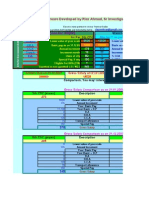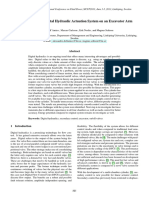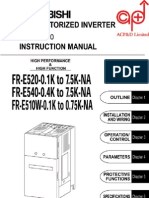Engine RPM Measurement Using Timer 1 (Embedded C Programming and The Atmel Avr)
Uploaded by
dinamik2tEngine RPM Measurement Using Timer 1 (Embedded C Programming and The Atmel Avr)
Uploaded by
dinamik2t130
The following code is placed above main() as the interrupt service routine for the Timer 0
overflow:
E X A M P L E
int time_cntr = 0;
/*global variable for number of Timer 0*/
/*overflows*/
/* Timer 0 overflow interrupt service routine*/
interrupt [TIM0_OVF] void timer0_ovf_isr(void)
{
TCNT0 = 6;
/*reload timer 0 for next period*/
if (time_cntr++ == 500) /*check for one second, increment counter*/
{
if (data_set_cntr < 120) /*record data if less than 120 sets*/
{
e_rpm[data_set_cntr] = current_e_rpm;
/*record engine rpm*/
s_rpm[data_set_cntr] = current_s_rpm;
/*record shaft rpm*/
temp[data_set_cntr++] = current_temp;
/*record engine temp*/
}
time_cntr = 0;
/*reset counter for next 1 second interval */
}
}
Notice that the data_set_cntr variable is post-incremented as a part of the storing of
the current temperature.
ENGINE RPM MEASUREMENT USING TIMER 1
The input capture feature is used to capture the period of the engine rpm pulses. The period
is used to calculate the rpm. Note that one pulse occurs for every two engine revolutions in
a 4-cycle engine such as this one.
The system clock is 8 MHz in this system, so using a prescaler of 8 will provide clock pulses
of 1 MHz with a convenient period of 1 microsecond. These clock pulses drive Timer 1, and
the input capture register (ICR1) will be used to capture the Timer 1 count each time a
falling edge occurs on the ICP of the ATMega16. When this occurs, an interrupt will be
generated. In the interrupt service routine, the current captured count is compared to the
previously captured time to determine the period of the pulses, which is used to calculate the
engine rpm.
The following code is placed in main() to initialize Timer 1 to capture the time on the
falling edge:
/* Timer(s)/Counter(s) Interrupt(s) initialization*/
TIMSK=0x21;
/* timer0 overflow, ICP interrupts enabled*/
/* Timer/Counter 1 initialization*/
TCCR1A=0x00;
TCCR1B=0x02;
/*prescaler = 8, capture on falling edge*/
TCNT1H=0x00;
/*start at 0*/
TCNT1L=0x00;
The A tmel RISC P rocessors
131
And the following code makes up the ISR for the capture event:
unsigned int previous_capture_time;
/*saved time from previous*/
/*capture*/
/* Timer 1 input capture interrupt service routine*/
interrupt [TIM1_CAPT] void timer1_capt_isr(void)
{
unsigned int current_capture_time, period; /*current time and*/
/*period*/
In this code, a global variable, previous_capture_time, is initialized to retain the
value from the previous capture. The ISR function reads the current capture time and uses
it, along with the previous captured time, to calculate the rpm. Notice the if statement that
checks for rollover; this is another method to allow for the case in which the 16-bit
timer/counter rolls over from 0xFFFF to 0x0000 during the elapsed period. The last statement in the ISR saves the current_capture_time for use as the previous_
capture_time the next time a pulse occurs.
The rpm is being calculated as follows:
RPM = 1E6 micro-seconds/second * 1 pulse / period in micro-seconds * 2 revolutions per pulse * 60 seconds per minute
Note that casting is used to ensure accuracy with the large numbers. Also, combining constants shortens the calculation formula.
DRIVE SHAFT RPM MEASUREMENT USING TIMER 1
This measurement gets a little bit more involved, because there is not a second capture register in the Mega16 and the shaft rpm signal is connected to INT0. You can create your own
capture register within the INT0 ISR by reading the Timer 1 count when the interrupt occurs. Then the rest of the function works very much like the one above for the engine rpm:
unsigned int previous_shaft_capture_time; /*saved time from previous*/
/*capture*/
/* External Interrupt 0 service routine*/
interrupt [EXT_INT0] void ext_int0_isr(void)
{
E X A M P L E
current_capture_time = (256* ICR1H) + ICR1L; /*get captured time*/
if (current_capture_time > previous_capture_time) /*check rollover*/
period = current_capture_time - previous_capture_time;
else
period = 0xFFFF - current_capture_time + previous_capture_time;
current_e_rpm = (unsigned long)120E6 / (unsigned long)period;
previous_capture_time = current_capture_time; /*save for next*/
/*calculation*/
You might also like
- 6th Central Pay Commission Salary Calculator100% (436)6th Central Pay Commission Salary Calculator15 pages
- RSS 131 User Manual All Units Rev R English0% (1)RSS 131 User Manual All Units Rev R English195 pages
- TC300 301 MH800 Troubleshoot Compressed1 - 47172No ratings yetTC300 301 MH800 Troubleshoot Compressed1 - 4717229 pages
- Dkg-217 Manual and Remote Start Unit With Synchroscope and Check Synch RelayNo ratings yetDkg-217 Manual and Remote Start Unit With Synchroscope and Check Synch Relay2 pages
- Epec 3606 Control Unit: Technical DocumentNo ratings yetEpec 3606 Control Unit: Technical Document49 pages
- Digital Weighing Indicator: Instruction Manual100% (1)Digital Weighing Indicator: Instruction Manual71 pages
- DTC B1135/24 Harf Connection in Airbag Sensor Assy ConnectorNo ratings yetDTC B1135/24 Harf Connection in Airbag Sensor Assy Connector2 pages
- Scan Tool Data List: Engine Control System (4HK1) 1A-39No ratings yetScan Tool Data List: Engine Control System (4HK1) 1A-3911 pages
- The Specifications of BX6680H: Details PDFNo ratings yetThe Specifications of BX6680H: Details PDF1 page
- 2.4.2 Electronic Module (E Module) CAN InterfaceNo ratings yet2.4.2 Electronic Module (E Module) CAN Interface2 pages
- Deep Sea Electronics Model 710 Configuration and Installation Instructions Typical Wiring DiagramNo ratings yetDeep Sea Electronics Model 710 Configuration and Installation Instructions Typical Wiring Diagram2 pages
- Tangkapan Layar 2024-09-22 pada 17.55.43No ratings yetTangkapan Layar 2024-09-22 pada 17.55.43114 pages
- Murphy Display For Volvo Penta 00-02-0604No ratings yetMurphy Display For Volvo Penta 00-02-060438 pages
- CDC 3231G-C Automotive Controller: MicronasNo ratings yetCDC 3231G-C Automotive Controller: Micronas36 pages
- Dacts704c Diesel Generator Auto ControllerNo ratings yetDacts704c Diesel Generator Auto Controller27 pages
- MikroElektronika Forum - View Topic - PICKIT 3 With MIkroC PRO100% (1)MikroElektronika Forum - View Topic - PICKIT 3 With MIkroC PRO5 pages
- 7 - 55-PDF - Genlyon Repair Manual (Part I)No ratings yet7 - 55-PDF - Genlyon Repair Manual (Part I)1 page
- Hino DX Activation User's Manual - Compressed PDFNo ratings yetHino DX Activation User's Manual - Compressed PDF14 pages
- Overview, Vehicle Management Computer, Sheet 1 of 3100% (1)Overview, Vehicle Management Computer, Sheet 1 of 31 page
- Advanced Arduino: Direct Use of Atmega Counter/TimersNo ratings yetAdvanced Arduino: Direct Use of Atmega Counter/Timers5 pages
- Motor Tachometer Speed Calculation Using Hardware Timer Capture FeatureNo ratings yetMotor Tachometer Speed Calculation Using Hardware Timer Capture Feature3 pages
- Uses, Standards and Construction of Cold RoomsNo ratings yetUses, Standards and Construction of Cold Rooms1 page
- Design of a Smart IoT-Based Control System for Remotely Managing Cold Storage FacilitiesNo ratings yetDesign of a Smart IoT-Based Control System for Remotely Managing Cold Storage Facilities29 pages
- Efficient food thawing process keeps the flavours, while minimizing losses - KometosNo ratings yetEfficient food thawing process keeps the flavours, while minimizing losses - Kometos1 page
- Controlled thawing minimizes thawing losses - KometosNo ratings yetControlled thawing minimizes thawing losses - Kometos1 page
- Freezing and thawing of processed meat in an industrial freezing tunnel - marini2014No ratings yetFreezing and thawing of processed meat in an industrial freezing tunnel - marini20148 pages
- Magnetic Effects in Sensing ApplicationsNo ratings yetMagnetic Effects in Sensing Applications141 pages
- Ubtech Alpha1s Digital Servo Built-In Avr Develop Board 6v-9v Ubt12hbNo ratings yetUbtech Alpha1s Digital Servo Built-In Avr Develop Board 6v-9v Ubt12hb1 page
- Compatibilities For Lenses of Panasonic Lumix DMC-G7No ratings yetCompatibilities For Lenses of Panasonic Lumix DMC-G75 pages
- Bracing Styles For Classical Guitars - This Is Classical GuitarNo ratings yetBracing Styles For Classical Guitars - This Is Classical Guitar8 pages
- The Lute Society - Building Lute Original Methods100% (3)The Lute Society - Building Lute Original Methods102 pages
- Panasonic Lumix DMC-G7 - Owner's Manual (For Advanced Features)No ratings yetPanasonic Lumix DMC-G7 - Owner's Manual (For Advanced Features)411 pages
- The Basics of Reading A Spark Plug - Honda-TechNo ratings yetThe Basics of Reading A Spark Plug - Honda-Tech19 pages
- Vocal Compression Guide: Can You Hear Me Now?No ratings yetVocal Compression Guide: Can You Hear Me Now?7 pages
- Xazbdikxco - Technical Specification-Vol 1No ratings yetXazbdikxco - Technical Specification-Vol 139 pages
- Detailed Lesson Plan in Technology and Livelihood EducationNo ratings yetDetailed Lesson Plan in Technology and Livelihood Education7 pages
- Computer System: Operating Systems: Internals and Design PrinciplesNo ratings yetComputer System: Operating Systems: Internals and Design Principles62 pages
- tdr-3000-guided-wave-radar-specification-sheetNo ratings yettdr-3000-guided-wave-radar-specification-sheet2 pages
- Model SD500-ARM Addressable Relay ModuleNo ratings yetModel SD500-ARM Addressable Relay Module2 pages
- aNJYSd16TRAAU4MALCB 10Gbs 300pin SFF Tunable Long Reach Product Brief RevBNo ratings yetaNJYSd16TRAAU4MALCB 10Gbs 300pin SFF Tunable Long Reach Product Brief RevB2 pages
















































































































